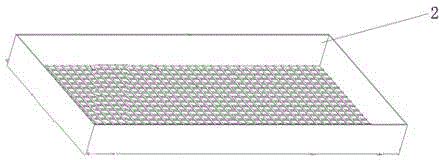Method for cultivating earthworms
A breeding method and earthworm technology, which are applied in the field of earthworm breeding, can solve the problems of destroying the living environment of earthworms, unfavorable for the preservation and reproduction of earthworms, affecting the hatching of earthworm cocoons, etc., so as to achieve easy harvesting, ensure the output of earthworms, and improve the reproduction rate. Effect
- Summary
- Abstract
- Description
- Claims
- Application Information
AI Technical Summary
Problems solved by technology
Method used
Image
Examples
Embodiment 1
[0029] Embodiment 1 (breeding with earthworms)
[0030] 1.1. Adopt a three-dimensional multi-layered earthworm breeding bed composed of a base box body 1 with a height of 30 cm and a bottom surface with drainage holes 101, and 4 earthworm breeding boxes 2 with a height of 20 cm stacked on the base box body 1. The bottom of the culture box 2 has a sieve hole with a diameter of 0.5cm; first fill the base box with river stones, crushed stones and fine sand successively and fill up to form a river stone layer, a crushed stone layer and a fine sand layer. The heights of the stone layer and the fine sand layer are 15cm, 10cm, and 5cm respectively, among which, the diameter of the river stone is 4cm-5cm, and the diameter of the crushed stone is 2cm-3cm;
[0031] 1.2. Mix the sludge (moisture content 70%) and crushed straw evenly according to the volume ratio of 7:3 to obtain the organic waste mixture, wherein the mass ratio of carbon and nitrogen in the organic waste mixture is 20:1;...
Embodiment 2
[0037] Embodiment 2 (raising of commercial earthworms)
[0038] 1.1. Adopt a three-dimensional multi-layered earthworm breeding bed composed of a base box body 1 with a height of 30 cm and a bottom surface with drainage holes 101, and 4 earthworm breeding boxes 2 with a height of 20 cm stacked on the base box body 1. The bottom of the culture box 2 has a sieve hole with a diameter of 0.5cm; first fill the base box with river stones, crushed stones and fine sand successively and fill up to form a river stone layer, a crushed stone layer and a fine sand layer. The heights of the stone layer and the fine sand layer are 15cm, 10cm, and 5cm respectively, among which, the diameter of the river stone is 4cm-5cm, and the diameter of the crushed stone is 2cm-3cm;
[0039] 1.2. Mix cow dung, pig manure, and crushed straw according to the volume ratio of 6:2:2 to obtain an organic waste mixture, wherein the mass ratio of carbon and nitrogen in the organic waste mixture is 20:1;
[0040]...
Embodiment 3
[0046] Embodiment 3 (raising of commercial earthworms)
[0047] 1.1. Adopt a three-dimensional multi-layered earthworm breeding bed composed of a base box body 1 with a height of 10 cm and a bottom surface with drainage holes 101, and three earthworm breeding boxes 2 with a height of 20 cm stacked on the base box body 1. The bottom of the breeding box 2 has a sieve hole with a diameter of 1 cm; first, in the base box body, river stones, crushed stones and fine sand are filled successively and filled up to form a river stone layer, a crushed stone layer and a fine sand layer, and the river stone layer, crushed stone The heights of the sand layer and the fine sand layer are 5cm, 3cm, and 2cm respectively, among which, the diameter of the river stone is 4cm-5cm, and the diameter of the crushed stone is 2cm-3cm;
[0048] 1.2. Mix cow dung and rotten vegetable leaves evenly according to the volume ratio of 8:2 to obtain an organic waste mixture, wherein the mass ratio of carbon and...
PUM
 Login to View More
Login to View More Abstract
Description
Claims
Application Information
 Login to View More
Login to View More - R&D
- Intellectual Property
- Life Sciences
- Materials
- Tech Scout
- Unparalleled Data Quality
- Higher Quality Content
- 60% Fewer Hallucinations
Browse by: Latest US Patents, China's latest patents, Technical Efficacy Thesaurus, Application Domain, Technology Topic, Popular Technical Reports.
© 2025 PatSnap. All rights reserved.Legal|Privacy policy|Modern Slavery Act Transparency Statement|Sitemap|About US| Contact US: help@patsnap.com



